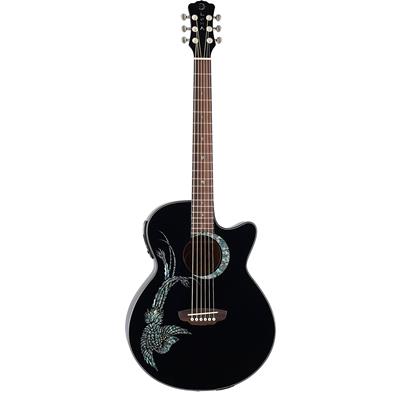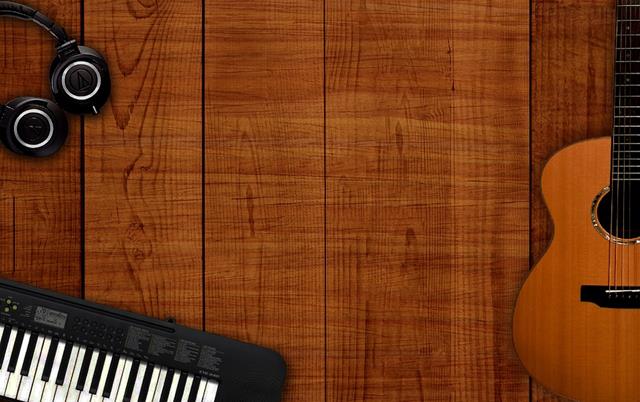Amplifiers are usually associated with electric guitars. As you watch your favorite rock band’s performance you probably have noticed lots of enormous amplifiers and equipment in the background BUT that does not mean that musicians who only use acoustic guitars don’t need amplifiers. Although the market for electric guitar amps is a lot bigger you can still find quite a few acoustic guitar amplifiers.
Whether you need a model for home practice or gigging, you won’t have a lot of trouble finding the best acoustic amplifier for your specific circumstances. And just like with electric guitar amps, prices for acoustic amps vary, a lot. So don’t fret if you are a beginner, you can always find a model in your price range. In this article, we will discuss seven of the best acoustic guitar amps and then talk about the different purposes of amps as well as what you should keep in mind if this is your first amplifier and don’t know where to start.
What’s The Best Acoustic Guitar Amp
| Image | Amplifier Model | ||
|---|---|---|---|
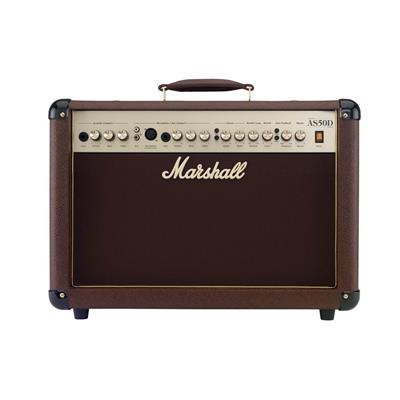 | Marshall Acoustic Soloist AS50D |  (4.9 / 5) (4.9 / 5) | Check on Amazon |
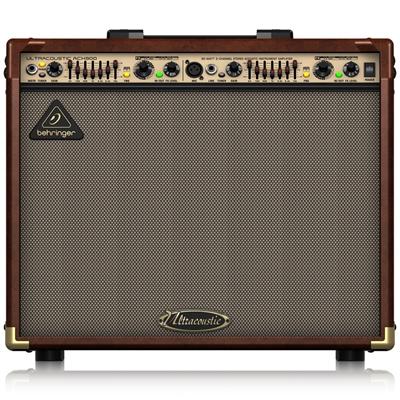 | BEHRINGER ULTRACOUSTIC ACX900 |  (4.8 / 5) (4.8 / 5) | Check on Amazon |
 | Fender Acoustasonic 40 |  (4.8 / 5) (4.8 / 5) | Check on Amazon |
 | Fishman Loudbox Mini Limited Edition |  (4.7 / 5) (4.7 / 5) | Check on Amazon |
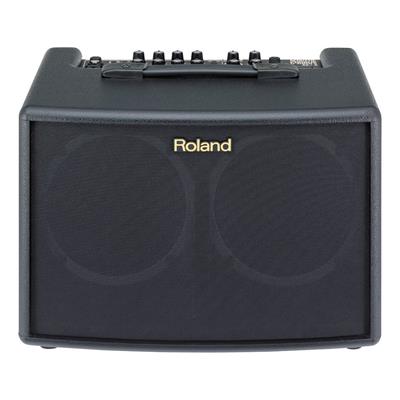 | Roland AC-60 |  (4.7 / 5) (4.7 / 5) | Check on Amazon |
 | Peavey Ecoustic20 |  (4.7 / 5) (4.7 / 5) | Check on Amazon |
 | Stagg 20 AA R USA |  (4.6 / 5) (4.6 / 5) | Check on Amazon |
Marshall Acoustic Soloist AS50D 50 Watt Acoustic Guitar Amplifier

Marshall is an iconic brand that enjoys widespread recognition, regardless of whom you inquire. Even if you approach a random passerby, it’s highly likely that they are familiar with the company. While they might not possess extensive knowledge about it, the name itself carries significant weight. The reason for that is that Marshall has been producing top-notch amps for every guitar, for every person, and for every budget for years now. Their Acoustic Soloist AS50D is a 50-watt amp with two channels allowing you to plug in two guitars with independent EQ for both channels. For just a 50-watt tiny model this amp packs in some nice power making it good for gigging in small spaces (not to mention home practice). It also features two 8″ speakers and great construction you can rest assured that the sound this amp will produce will be authentic and clear, just like you would want for an acoustic amp.
Pros:
- Excellent response to the pick-ups
- Wide range of sounds and features
- Easily configurable
- Amazing clean tones
Cons:
- Not the most powerful acoustic guitar amp out there
BEHRINGER ULTRACOUSTIC ACX900

Just under the $300 mark, this Behringer Ultracoustic ACX900 amp offers a lot for quite an affordable price. First, let’s start with the wattage – the 90-watt power is pretty good for gigging. You will be able to perform in front of small and mid-sized audiences without a problem. The model also has 2-channels with separate controls. So you can plug in one acoustic guitar and use the other one for vocals. Also, each channel has a 9-band graphic EQ for tone shaping which will allow you to take control over the tone of your guitar. The two 8″ dual-cone speakers allow for the sound to come out clear and fresh as a breath of fresh air. If you are concerned about feedback (which is an issue with a few more affordable acoustic guitar amps) the FBQ Feedback Detection system will easily reduce feedback. All in all, for a gigging musician, this is one of the best acoustic guitar amps.
Pros:
- Excellent build-quality
- Feedback Detection function which cuts down on feedback
- Decent overall sound
- Nice pack of features
Cons:
- On-board effects are not as good as the ones offered by a quality processor
- The knobs are made out of plastic
Fender Acoustasonic 40 Guitar Amplifier

If you’re familiar with Fender solely for their outstanding craftsmanship, elegant designs, and awe-inspiring guitars, get ready to be amazed by their equally remarkable amplifiers. In all honesty, Fender has established itself as a leading producer of top-tier acoustic guitar amps in the market. I don’t know how they do it and I don’t wanna know. I’m just glad they do and that they don’t stamp a ridiculous price tag on most of them. This Acoustasonic 40 amplifier is an amazing option if you are looking to amplify your acoustic-electric guitar and microphone. The model is also pretty lightweight so if you travel a lot for gigs, or for any other purpose, and want to take your amp everywhere it’s not going to be a problem. The construction also allows for the model to be very durable and stable so you won’t have to worry about putting the amp in the back of the van and having it ruined because of bumping into other equipment and instruments. With the high-frequency response, “Whizzer” cone, a channel with built-in reverb as well as ¼” jack for an instrument, and an XLR input for a microphone you will be getting perfect for gigging and on-the-go amp just under $200.
Pros:
- Can be used for multiple purposes
- Lightweight and portable
- Extremely durable
- Quite affordable
Cons:
- The selection of on-board effects might not be enough for some
Fishman Loudbox Mini Limited Edition

If you are looking for an acoustic guitar amplifier for gigging, practice, and recording look no further. Fishman Loudbox Mini Limited Edition is all in one. Moreover, it all fits in this mini-sized amplifier that is easy to carry around and store (although you will not want to because you will be playing in 24/7). Just like with the previous amps, this model has two channels for the instrument and one for a mic. It also features 3-band instrument EQ (including low, mid, and high tone controls) and 2-band microphone EQ (including low and high tone controls). Apart from that this compact amp has Digital reverb and chorus effects and a feedback-fighting phase switch so that you won’t get any feedback during a performance. It’s 60 watts and has a pretty powerful sound that can be used for events in small and medium-sized halls while also having a clear enough tone to produce sound good enough for recording. If you’re a musician on the move, dealing with the challenge of lugging around instruments and equipment, all while working within a limited budget for an amplifier, this model is an ideal solution tailored to your requirements.
Pros:
- Separate channel for the microphone
- Has a phase switch which eliminates the feedback
- Tailored for acoustic guitars
Cons:
- Does not have the headphone jack for silence practice
- Does not offer a wide range of features (just in case that is a deal-breaker for you)
Roland AC-60 – 30W 2×6.5″ Stereo Acoustic Amp

Another amp from Roland, this AC-60 is a 30-watt acoustic amplifier with 2 channels and Onboard DSP that provides stereo/multi-band chorus, as well as wide chorus and delay/reverb using footswitch control. It’s easy to use and pretty intuitive. Apart from that, this model is small enough and lightweight enough to be carried around with no problem. While this model is only 30 watts and might not seem to have enough power on the paper, once you plug it in you will see that the dual 6-1/2″ speakers will provide enough volume to be heard in quite big spaces. This amp, most importantly, helps you deliver a more authentic, rich tone that is incomparable to most instruments. While this is a more expensive model (just under $500) I would definitely recommend it to someone who is serious about gigging. As for beginners, well… if you are ambitious enough and think you will be gigging pretty soon this might be a good option, too.
Pros:
- Wide range of useful features
- Excellent on-board effects
- In-built anti-feedback system
- Great sound quality
Cons:
- Does not have an effects loop
- Might develop a certain hiss in some settings
Peavey Ecoustic20 20W Acoustic Guitar Amplifier

Going from the more expensive (relatively) model, let’s talk about Peavey Ecoustic20 20W Acoustic Guitar Amplifier – a pretty affordable model that will be a great starting point for someone who plans of gigging or has already started and wants a cheaper model without compromising quality (don’t we all…). First of all, if you are new to amps, Peavey is a “trustworthy” brand. I have personally had several of their amps. They create models for any style and guitar and manage to do so without overpricing them. This specific solid-state amp features 2 channels (both having separate level controls) and a premium full-range loudspeaker. With its rich and clear tone, this amplifier provides an exceptional sound suitable for both home practice and live performances. Despite its 20-watt power, the model produces an impressive presence that exceeds expectations, particularly when playing in intimate settings or before smaller audiences. All in all, this Peavey model proves once again that the company is a master of making cheap in price but not in quality models that are great for beginners and for traveling.
Pros:
- Excellent build quality and extremely durable chassis
- Great sound and tone shaping options
- Affordable
- Easy to use
Cons:
- Does not have any on-board effects
- Might not be versatile enough for some
Stagg 20 AA R USA 20 Watt RMS Acoustic Guitar Amplifier

Last but not least, we got to talk about Stagg 20 AA R USA 20 Watt RMS Acoustic Guitar Amplifier. With a single 6.5″ speaker, 3-band EQ (Bass/Middle/Treble) along with separate Parametric Mid control, this model allows you to have full control over the sound and volume of your instrument. There is also headphone output if you want to practice at home in silence and a lot of other features that make it one of the best acoustic guitar amps in its price range. While this amp might not be cut out for big venues, if you want to gig in small venues (like coffee shops or little gig places) this baby is great for several reasons. The first and the most important one is the tone and its richness. Talk as much as you want about power and all, unless the amp provides that crisp, authentic sound of an acoustic guitar there is no point to it. It’s also small and compact so you will not break your neck transporting it.
Pros:
- Beautiful design
- Well-built
- Excellent sound quality
- On-board spring reverb
Cons:
- Not powerful enough for big venues
Acoustic guitars come in different shapes, sizes, and prices. They are created for different purposes and with various features. And as a beginner, it might be a bit intimidating to learn all about them (especially, if you just spend a couple of months finding out which acoustic guitar to buy). But fret not, you will sooner or later figure out what fits you the best.
Unlike electric guitar amps, the purpose of acoustic guitar amps is not to add different effects but to let the sound of the guitar be amplified as accurately as possible. You won’t have to know too much about Reverb, distortion and all that stuff (well, it never hurts to know that stuff anyway). So that’s one good thing but at the same time, there are other things to think about when researching acoustic amp models. I will try to give overall tips and what mistakes not to make.
Purposes
I have talked in many other articles about the importance of knowing why you need your amplifier (check out our list of the best guitar practice amplifiers). The key is not to go for an amplifier made for a very specific niche when you need an absolutely different one.
One of the main reasons why you might want to get an amplifier is to practice at home. And while a lot of people don’t want an amplifier to practice on their acoustic guitars, trust me, there are a lot of plusses. For instance, maybe you want to be more “acquainted” with the sound of your acoustic guitar amplified so that when the day comes and you play in front of an audience you are not going to be blindsided by sound and tone that the amp makes. In that case, you want to get yourself a practice amplifier. Another great thing about practice amps is that they are usually a lot cheaper than other models. They are also more compact and easy to move around. I would definitely recommend looking into them if you are a beginner or practice at home and don’t want to make a lot of noise (because practice amps also tend to have lower wattage).
Maybe you have practiced enough and now decided to play venues. Well, first of all, congrats on being somewhat close to your goal. Second of all, your practice amp will probably not be sufficient enough for a venue. Of course, the size of the venue also matters. If you plan on performing in a small coffee house or in a very small space a practice amp might actually be enough. For other purposes, you will need an amp that has a lot higher wattage. Anything over 30-watts is considered to be a more mid-powered amplifier so go for that. Gigging amps are also great because they won’t be drowned out by other instruments and you won’t end up on a stage looking like you’re there just as a decoration piece.
For the purpose of recording, you will want to focus on clarity of the sound and extra effects rather than the wattage. It will also be smart to consider an amp with different effects so that your sound has more depth and complexity, but of course, that is up to you.
Conclusion
I remember when I got my first guitar. While a lot of years ago, the feeling still is fresh in my mind. And the first time I actually manage to play an entire song without screwing something over was diving. While I thought that nothing would make that experience any better I was pretty wrong. After years of practice and different guitars, I ended up saving enough (which is not a lot) to get my acoustic guitar amplifier and nothing was the same again. It pretty much transformed the way I played, and allowed me to gig and get around with it everywhere I went (well… not everywhere but still). So whether it is an amplifier for an electric guitar, an acoustic guitar, or whatever you play, quality is always something that you should not compromise. Of course, you might want to get one that’s under a certain price range but never go for an amp just for the price. That’s especially important with acoustic guitar amplifiers that are responsible for producing the clearest and most close to authentic sound to the actual guitar (but amplifier). Apart from that, there are a lot of other requirements you might have. Some of the best acoustic guitar amplifiers that we had on this list are also some of the best small acoustic guitar amp and the cheapest (relatively). In any case, I hope this article was helpful and you have found an amplifier that you want. If not, good luck finding a perfect amp that will make your experience better and better with every practice, gig, or recording.



